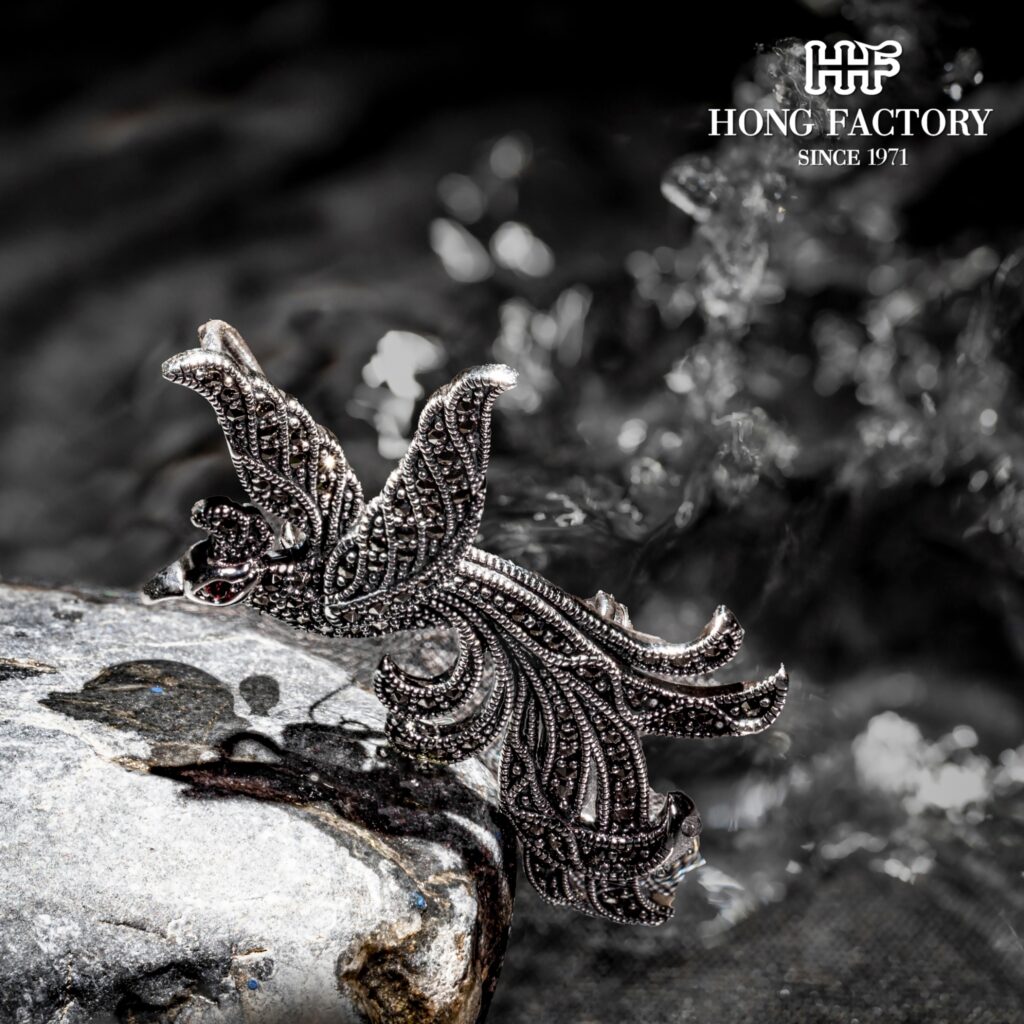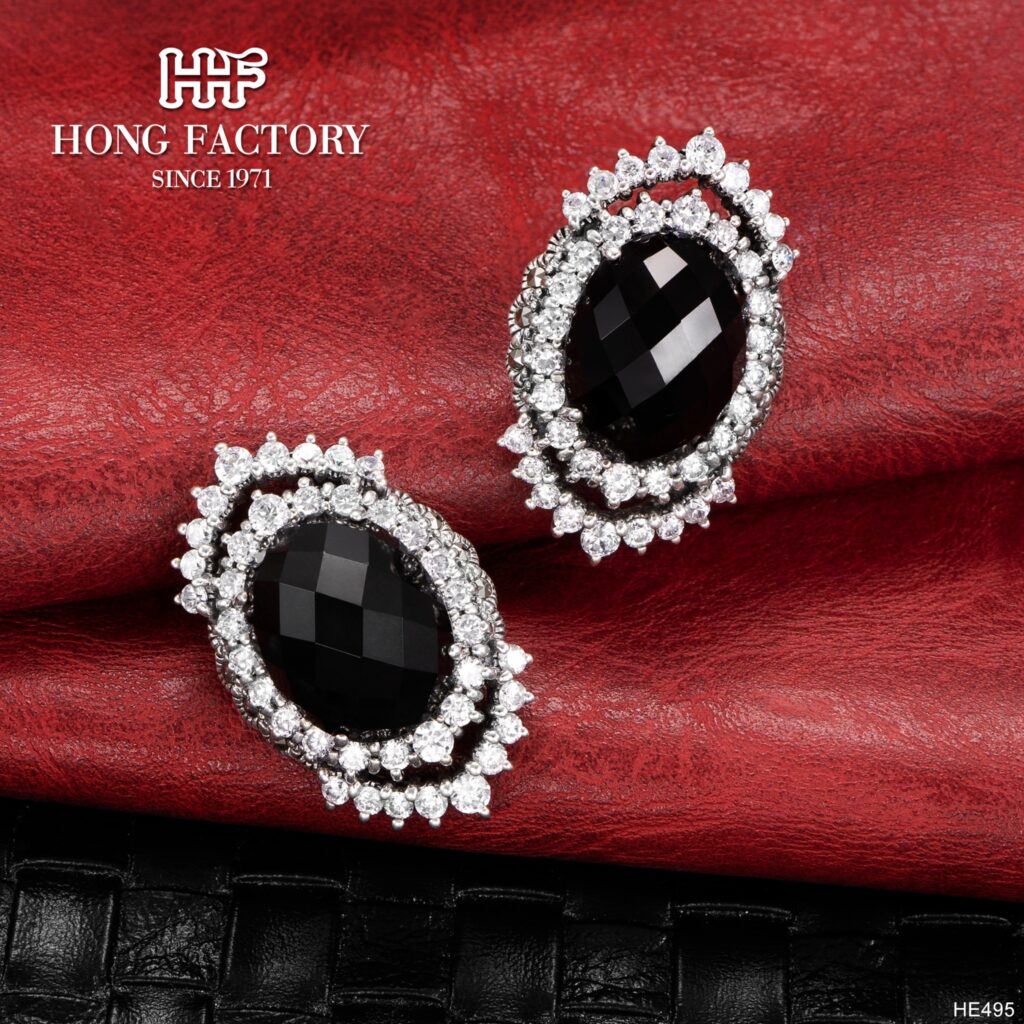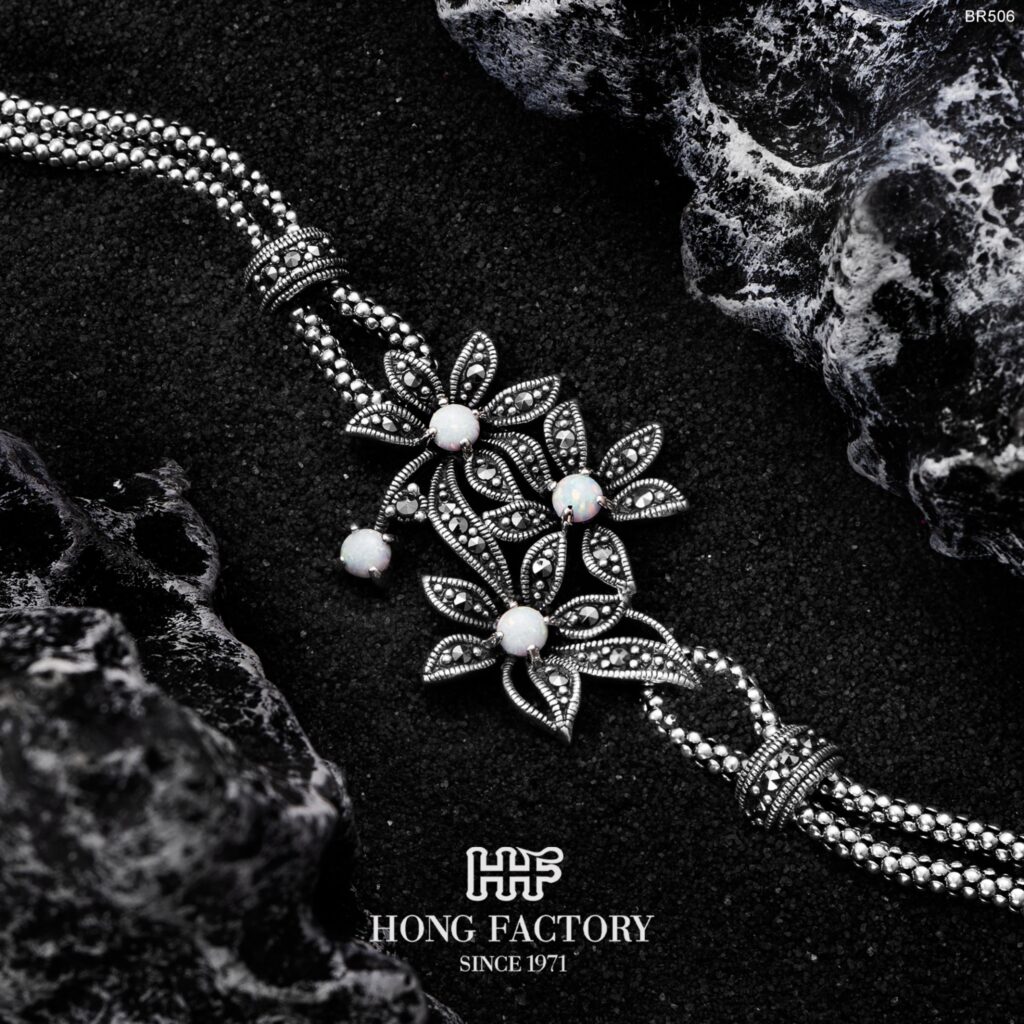What is Marcasite Jewelry
Vintage marcasite jewelry is a classic and elegant way to accessorize, offering consumers examples from style eras as vivid as the Victorian Era, Art Deco and the modern times. Even new pieces look like antiques, which makes the accessories timeless additions to your wardrobe. Marcasite has a rich history as a luxury gem and has a tremendous use in ancient times. Let’s explore more about this timeless mineral and Hong Factory’s Exclusive Marcasite Jewelry Collections or visit our jewelry booth at the leading International Jewelry Fair throughout the year.
What is Marcasite stone is a genuine, natural gemstone with a bright sheen and a stunning sparkling metallic lustre. The color of marcasite stone is a pale bronze or brassy shade with dark streaks of grey-green. It is opaque stone with the hardness scale of 6 to 6.5. It is common for it to be cut into round cabochon shape with 6 facets and 0.9-2.0 mm diameter. Marcasite stone are available in many more shapes and sizes from Square cut, Baguette cut, Rose cut, Round table cut, Round brilliant cut, Fan cut, Shield cut, Checkerboard cut, Honeycomb cut, Dome cut, and Peak cut.
Marcasite has been used for personal adornments as far back as in ancient times. The mineral in marcasite jewelry is not in fact marcasite but iron pyrite. The name Marcasite is derived from the Arabic word for Pyrite. The confusion between the two minerals is amplified as the jewelry trade uses the trade name of Marcasite when in reality what they are selling is Pyrite. Because of iron pyrite’s resemblance to marcasite, jewelry from this mineral became known colloquially as marcasite jewelry. However, true Marcasite cannot be used in jewelry as it has a higher tendency to crumble into a powder.
In contrast, Iron pyrite has a hardness that allows it to stand up well to scratches and dings over the years, and thus gives consumers the ability to find quality vintage pieces in good condition years after their creation. Having similar appearance and physical properties and the same chemical composition as Marcasite but with different crystal structure, Pyrite is thus a polymorph of Marcasite and it can be extremely difficult to distinguish between the two. It was not until 1845 that marcasite was recognized as an orthorhombic iron sulfide and pyrite crystallizes in the isometric system.
Pyrite is found in many parts of the world, but only a small fraction of it is suitable for the cutting processes required to create marcasite jewelry. Only precise cutting and polishing techniques can reveal the essential beauty of the stone and provide an elegant and shimmering finish.

ANCIENT USE OF MINERAL IN MARCASITE STONE
The mineral in marcasite stone is in fact iron pyrite. The name Pyrite comes from the ancient Greek word “pyr” meaning “fire,” and was named such because it was found that sparks would fly from it if struck against another mineral (best if Iron or Steel). In early times, this sparking ability gave man one way of creating fire; in later times, this ability made it popular for use in early firearms devices such as the wheel lock. Today Pyrite also carries the name of “Fool’s Gold” for the simple reason that many throughout history have mistaken it for Gold because of its similar visible structure, metallic luster and brassy yellow color. Ironically, Gold is often found adjacent to Pyrite deposits, and the only thing foolish about finding “Fool’s Gold” would be in not searching a bit farther! Pyrite can be simply distinguished from Gold; Pyrite being lighter in color and much harder, whereas it cannot be scratched with a fingernail or knife as Gold can be. But even though Pyrite is a fairly hard mineral, its crystals are known to break and crumble, as it is brittle.
Pyrite mineral in marcasite stone may even have been the first non-herbal medicine: when burned, it emits sulphur oxide gases that can clear sinuses when inhaled. It has been used just as long as a source of iron sulfate, an old school method of treating anemia. To get the iron sulfate, a mound of pyrite was left outside to weather. The runoff was collected and boiled, leaving behind iron sulfate to be used much the same way iron supplements are today. This also became the preferred method of acquiring sulfuric acid, a vital ingredient for fertilizer. The mineral was also a source of pigments such as red ochre, which is produced when pyrite oxidises in aerated water.
Pyrite has had a historically unrecognized influence on developing the world as we know it today. Much of what we know about the history of Earth has come from investigating ancient pyrite. For instance, pyrite crystals that formed around ancient deep-sea vents have been used to map volcanism and to measure planetary cooling. In fact, pyrite has even begun to show its worth to gold prospectors. Most gold mined today is in the form of microscopic blebs trapped inside minerals. Ironically, pyritic ores are the richest source.
It wasn’t until the 20th century pyrite started getting used in electronics. Originally, it was used in crystal radios during near the start of the century, until vacuum tubes became the norm. Recently, it’s being used in batteries and has been proposed as a main component of solar panels. Like the silicon used in conventional solar cells, pyrite is a semiconductor but, it “absorbs 100 times as much light”. And it is ultra-cheap, too. This rich history of mineral in marcasite stone can extend from human evolution and culture, through science and industry, to ancient, modern, and future Earth environment and can go on without boundaries.
ANCIENT HISTORY OF MARCASITE JEWELRY
Marcasite has been used to make jewelry throughout history. Marcasite jewelry has been made since the time of the Ancient Greeks. The Incas were the first known users of Marcasite for jewelry – pieces have been found in ancient burial chambers. It was also used by the Native American Indian Shamans – who believed it to have healing and soothing properties, using it in their sacred rituals.
During the reign of Louis 14th of France, only the King was allowed to wear genuine diamonds. Diamonds were used as an instrument of separation by European nobility. If you were wearing diamonds, you were seen as a high-class person. Diamonds and other similar jewelry were not readily available to the common folk. Even if they could afford diamonds, commoners were sometimes restricted by law to live their lives without these precious gems in their jewelry.
If they were able to afford jewelry, common people wanted to be able to wear it. Wearing jewelry, no matter what it was made from, became an extremely popular fashion statement. Marcasite became very popular in the region as a diamond imitation, and was worn by high society and also by women at court. It was a way to flaunt wealth and display high-class sensibilities, regardless of class or social hierarchy.
Later, Marcasite jewelry was particularly popular in Victorian era. When Queen Victoria lost her husband Albert in 1861, she entered a mourning period and chose to wear black clothing and jewelry symbolic of a widow, and her loyal subjects followed suit. Diamonds were seen to be too opulent for the mourning period. Marcasite became popular as an understated alternative for the nobility.
Soon, Marcasite became the jewelry of choice for the middle and upper classes for its elegance, and for its ability to be combined with pearls. However, Marcasite is no longer the poor relation to diamonds, having become highly regarded in the world of jewelry design in its own right. Marcasite jewelry was cherished in the UK and quickly gained in popularity and soon reached a wide audience.
MARCASITE VINTAGE DESIGN FEATURES
Marcasite Jewelry has a unique character, often showcasing vintage design elements not seen in many mass-produced modern pieces. To truly explore the influence of the ancient time into marcasite jewelry, we break the vintage style and intricate details with common motifs that many iconic and historic jewelry designs feature.
HALO STYLE RINGS
The halo ring is a setting that encircles a center gemstone in a collection of round pavé or micro-pavé diamonds (or faceted color gemstones). These pavé stones flash with light and focus attention back on the center stone to create interest and draw people’s gaze to your ring. Halo style rings are one of the most characteristic vintage ring styles that were dominant in the Art Deco Era. Halo rings are almost as classic as solitaires, but with a stylish twist. The halo design is so strong that they are still very much in style today.

SCROLL MOTIF RINGS
Among the design flourishes in our vintage ring styles guide, the scroll motif is the oldest as it has been a part of jewelry and art for at least three millennia. The use of scrolls in ornament goes back to at least the Bronze Age; geometric scroll ornament has been found in the Palace of Knossos at Minoan Crete dating to approximately 1800 BC. In one common spreading type for wide areas, the basic form of the arabesque is a heart shape formed from two confronted volutes on stem. To this core are added any number of further volutes, above, below or to the sides. In other types, the scroll taking the form of an “S” with voluted ends, generally seen in confronted pairs.

BOW MOTIF RINGS
The bow motif is one of the most characteristic flourishes of the Edwardian Era. It already existed and was very popular during the Georgian and Victorian Era, but it hit its stride during the early 1900’s. Although the bow element of the motif is usually expressed in metalwork, it is not uncommon to see the diamonds also play a part of the motif.

FLORAL MOTIF RINGS
The flower motif has transformed into enduring beauty throughout the periods of jewelry history. In the Victorian Era, lovers were obsessed with secret languages assigned to love tokens. Flowers were assigned specific meanings. For example, a daisy meant innocence, while a sunflower indicated adoration. Art Nouveau ran along the same timeline as the Edwardian Era and its design follows the more organic and realistic rendering of the floral structures.
During the Art Deco Era, the more interpretive and symmetrical floral designs became very popular, and their design borrowed elements of the floral elements and balanced the shapes against each other. In the Retro Era, jewelers now incorporated movement in floral motifs, especially important, as embodied in the sway of the dangle earrings. Big, chunky jewelry often featured articulated petals and leaves – though bolder and less realistic.

LEAF MOTIF JEWELRY
Leaves are seen as both accent and focal points in Victorian, Art Nouveau and 20th century jewelry. The Renaissance inspired the early Victorian era with flowers, branches, leaves, grapes and berries dominating the design motifs. The Art Nouveau period saw a resurgence of enameling, a metal technique that lends itself to the free-flowing lines of flowers and leaves.

ANGULAR STYLE RINGS
As some of the most modern and striking designs in our vintage rings style guide, Art Deco designs encapsulate the era’s love of all things sleek and streamlined. Reminiscent of the famous buildings built during the Art Deco Era, the Art Deco Rings during this period had a striking and angular sense of balance and symmetry. Sharp corners and long lines that mirrored each other are very characteristic of this motif.

ANIMAL MOTIFS
The use of animal motifs in ornament goes back to at least the 3rd century BCE, where the bracelet in the shape of a serpent originated and remained popular through the Roman period. In the Victorian Era, animals were assigned specific meanings. Queen Victoria, was married in 1840, and she wore a snake motif ring (a symbol of eternal love at the time) set with her birthstone, a brilliant green emerald, as her engagement ring. The design of jewelry can poignantly express the giver’s feelings and hopes. For example, dogs symbolized fidelity, butterflies symbolized the soul, salamanders and lizards symbolized passionate love. Look for beautiful, gem-set butterflies, enameled beetles, silver monkeys and even lovely house flies.

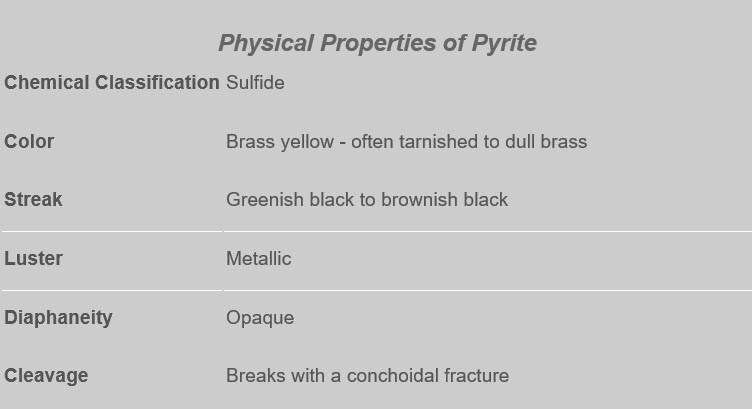
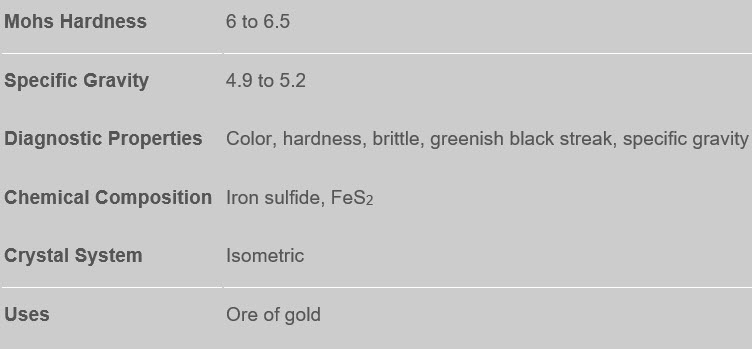
HEALING PROPERTIES
• Marcasite stone (Pyrite mineral) is believed to be a protective, shielding stone and is excellent to wear or carry as an amulet to deflect harm and danger. It is especially helpful when one is away from home or performing hazardous work.
• Marcasite stone guards against ongoing control, criticism and manipulation by a partner, parent or employer, lending the power to resist without becoming angry or upset, changing the balance of power.
• A piece of marcasite stone in the home or workplace energizes the area around it and imparts an immediate increase in vitality. It overcomes intellectual fatigue due to overwork and tiredness of the nervous system by stimulating blood flow to the brain, increasing mental clarity, focus and recall
• The marcasite stone can inspire creativity in art, mathematics, science, architecture and many disciplines, especially those that recognize the inherent perfection and harmonious symmetry of nature and the universe. It stirs the qualities of ambition, commitment and perseverance, and is an ideal stone for students.
• In the workplace, marcasite encourages leadership qualities and is an ally for managers and those working toward promotion.
• Marcasite stone enhances the protective and assertive male energies in both men and women. It boosts women’s self-worth and helps overcome tendencies toward servitude and inferiority. For men, it instills a feeling of confidence in one’s masculinity and supports the enthusiastic expression of male eroticism.
NOTEWORTHY LOCALITIES
Marcasite stone (Pyrite) is an extremely common mineral, and good examples occur in numerous localities throughout the world. Only well-known localities are mentioned here.
Enormous deposits of Pyrite in the form of small crystal clusters exist in the Huaron Mining District in Peru. Other outstanding Peruvian localities are the Quiruvilca Mine, La Libertad; and the Huanzala, Huánuco. Most of the amateur collector Pyrite comes from the Peruvian locations in abundance, though fine outstanding crystals have also come from there as well.
In the Ampliación a Victoria Mine, Navajún, La Rioja, (formerly Logroño), Spain, large perfect cubic Pyrite crystals, are mined in abundance. They are frequently embedded in a light brown matrix, and are occasionally inter-penetrating. Excellent pyritohedral crystals occur in Rio Marina on the island of Elba, Italy, which is a classic locality. A locality which has recently brought interestingly shaped, complex Pyrite crystals to the market is the Merelani Hills, Arusha, Tanzania.
In the U.S., fine Pyrite localities abound. In Park City, Bingham Co., Utah, large, well shaped pyritohedrons and cubes were once found. The Bingham Canyon Mine, Salt Lake Co., Utah is also a classic occurrence, where few of the excellent Pyrites from the mine are saved from the mining crusher. Large, intergrown cubes, many times partially octahedral, occurred in abundance at Leadville, Lake Co., Colorado. Pyrite “dollars” are well-known from Sparta, Randolph Co., Illinois. The French Creek Mine in Chester Co., Pennsylvania is famous for the octahedral crystals that occur there, although most are distorted. Ross Co., Ohio, produces rounded tubular growths of Pyrite, some reaching several feet in size, as well as growths of spiky, pineapple-like crystals.



